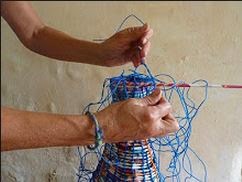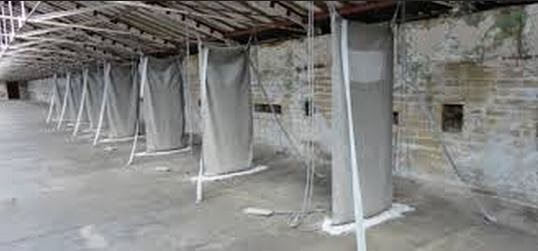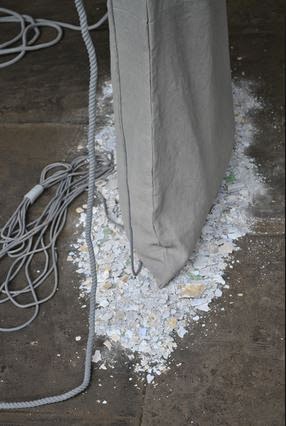Project 2
Stage one- Research six artists or designers
Matthew Harris
Matthew Harris
www.stroudinternationaltextiles.org.uk
This
is taken directly from http://www.artsfoundation.co.uk/
Goldsmith’s trained Matthew Harris has never
been interested in 'perfect' textiles. It’s the interruption of the patterned
surface which excites him. Cloth made imperfect as a result of patches, tears,
darns and frayed edges held together with purely necessary stitches; these are
the qualities which motivate him to make work.
Harris’ practice makes reference to a number of textile traditions but also to a wide variety of other sources and influences, including music. This interest was sparked by a friendship with the conductor Martin Brabbins, who showed him the highly individual language of notation employed by the composer, Karlheinz Stockhausen.
With drawing and music coming together, this
connection led to several commissions; in 2001 he was commissioned to make the
backdrop for the Cheltham International Music Festival. Harris completed his
first large-scale public commission for the new Colston Hall Concert Venue in
Bristol in March 2009.
Matthew Harris’ innovative cloths are labour-intensive, constructed using a number of simple hand techniques. The process of drawing is an essential part of his practice. He has developed a method of working that explores ways of translating the drawn marks into cloths. He tries, wherever possible, to exhibit both drawing and cloth together. Through a process of painting, cutting, patching and hand stitching, Harris constructs abstract images.
Harris has exhibited in many prestigious
venues both in the UK and abroad.
The next section is an
interview with Harris. The interviewer
is unnamed was but it was conducted at the time of the Stroud Festival. It gives a different sort of information to
that above. www.stroudinternationaltextiles.org.uk
When did you first become interested in
textiles?
I’m not sure that I could say exactly when I became interested in
Textiles. What I can remember is being very excited by the process of dyeing
and the potential of colour in cloth on my Foundation course at Hereford.
Where did you study and was this
experience a pivotal part of your creative journey?
I studied Textiles at Goldsmiths College. It was hugely important to the
way in which I began to think about working and making work. It was a course
that allowed students to develop completely individually over three years and I
was fortunate enough to be taught by a number of very well respected artists
and designers.
What are your main sources of
inspiration?
I wouldn’t say that I have any main sources of inspiration. My intention
is to always be open to the potential of any visual information to become the starting point
for work. There are often recurring themes in the work and ways of thinking
about process that underpin many of the ideas. Ultimately I am inspired by the
potential of abstract imagery to evoke curiosity and emotion in the viewer
Do you work with sketch books?
Yes, I do work in sketch books. I tend not to use them for planning or
plotting out but purely
as a way of gathering visual information that can act as a starting point for work.
as a way of gathering visual information that can act as a starting point for work.
What materials do you particularly like
working with?
I made a conscious decision when I started to make textiles again that I
would keep things very simple. I tend to use just one type of cloth which is a rough
cotton and I paint on with cold Procion Dye.
Where do you work? Do you have a studio
or a particular place where you work?
I work from a studio in the garden at my home in Stroud.
How do you see your work developing?
Who knows! I hope the imagery is always developing as I see and
experience new things. I would like to find ways in which to take the work out
into the world more by doing design work and perhaps more commissions.
Has your work changed and evolved
recently and if so in what way?
A recent commission for Colston Hall in Bristol, made me think about
working in a new way by forcing me to translate my ideas using different
materials. This process was interesting and has made me think about how work
might be extended and developed from one off gallery pieces. I have also
recently started to play with the
potential of very small- scale pieces of work that in combination can create a
large image.
Is there particular artists’ work you enjoy and admire?
There are many people whose work I look at and admire. On the whole I
look at the work of painters as opposed to
Textile artists but I am also interested in design and in particular music and
the ideas composers have about structure and composition. If I had to name one
person it would be the painter Prunella Clough, whose abstract paintings, often
derived from mundane and everyday objects, always convey a sense of endless
visual possibilities.
What plans do you have for exhibitions
and work in the coming year?
I currently have work at the Waterside Art Gallery in Sale, Manchester
as part of the Men of Cloth Show. I also have work in Taking Time, Craft and
the Slow Revolution a touring show that is at various venues in the U.K until
2011. My next big show will be in February 2011 at the Victoria Art Gallery in
Bath. This will be a joint show with the Mosaic Artist, Cleo Mussi.
Your web address
www.matthewharriscloth.co.uk (This is a brilliant web site crammed full of information). IB
www.matthewharriscloth.co.uk (This is a brilliant web site crammed full of information). IB
Lantern cloth No 1 - 170 x 99cm
Last year I was lucky enough to see some of Harris’s work at
the Harley Gallery and wanted to bring it home with me. I bought a very slim book (Harris 2008) that
at least gave me some pictures to look at.
In a short essay at the beginning of the book Michael Brennan Wood
describes Harris’s studio:
I felt as if I was in the pages of a
giant sketchbook. I noticed photographs
of crumpled aeroplane wings, chipped wall surfaces, Japanese temples, old
texts, scraps of cloth and paper, tiny experiments in cloth and pigment, skein
thread, waxed paper bound by reels of linen.
The walls and floor were stained, marked with the outline ghosts of
previous pieces. Colour was everywhere,
putties whites, ochre reds sepia, sooty blacks and fugitive slightly blurry
marks.
I think this gives a really good sense of the person and the
artist. Writing in the same book Paul
Harper talks of the way Harris works:
Harris does a great deal of
preparation and experimentation so that when he comes to make the finished
piece he has a clear idea of what he is looking for. Whilst this approach can be seen as highly
systematic, it is about immersing himself in a process so that he can work
intuitively.
Harris's studio
Bibliography
M, Harris. (2008). Trace Elements. University of
Glouscestershire.
M, H. (n.d.). www.matthewharriscloth.co.uk.
M, Harris. (n.d.). www.stroudinternationaltextiles.org.uk.
Lois Walpole
Lois Walpole
Born in
London in 1952 she lived there from 1972 until 2005. Now
divides her time between the Charente in South West France and Yell in the
Shetland Islands.
Her artistic
education began at Bristol Polytechnic in 1971 (Foundation) and she graduated
from St Martin’s School of Art with a B.A. (Hons.) in Sculpture in 1975. City
and Guilds qualifications in Basket Making from the London College of Furniture
followed in 1982 and in 2003 she completed a Doctorate at the Royal College of
Art in London.
Lois has
exhibited her work continuously since 1982, details of which are on the Exhibitions page of this site.
In 1984 her name was added to the Index of Selected Makers at the UK Crafts Council. She is also a member of the Basketmakers’ Association, the Scottish Basketmakers Circle and a Yeoman Member of the Worshipful Company of Basketmakers.
In 1984 her name was added to the Index of Selected Makers at the UK Crafts Council. She is also a member of the Basketmakers’ Association, the Scottish Basketmakers Circle and a Yeoman Member of the Worshipful Company of Basketmakers.
Teaching is
an important part of her work. From 1983 to 1988 Lois was a part-time lecturer
at the London College of Furniture with responsibility for the City &
Guilds Basket Making course and since 1985 she has been a visiting lecturer on
a one-off, or occasional basis at many colleges and Universities in UK and
abroad. From 1991 to 1994 Lois was an External Assessor for the Wood, Metal and
Plastics Degree Course at the University of Wolverhampton. She has taught
workshops for many groups and organisations and currently also offers tuition in her own studio, details of this can be found on the Tuition
pages of this site. She also gives public lectures wherever she is
invited to do so in Britain and abroad.
In 1987
with the help of family members she set up Rapid Eye Baskets a limited
company that was dedicated to producing contemporary ranges of domestic baskets
using sustainable materials such as cardboard and Finnish birch ply. The
baskets were all designed by Lois and produced by a small group of British
craftsmen and women. The company ran for 11 years and during that time sold
many baskets to stores such as Esprit de Corp, the Conran Shop and Liberty’s.
Since 1986
she has also designed ranges of baskets for other companies and for production
by other people such as Body Shop, Marks and Spencer, Paul Smith Women’s wear, Tetra Pak
and Jiva Co in Japan.
Her work has
been written about in many books and articles and has been featured on
television and radio in Britain and abroad.
She has also
written 3 books and authored articles and reviews for ethnographic and
specialist magazines as well as exhibition catalogues.
The following information is taken from “Urban baskets
tradition recycled” 2010
This book is the catalogue detailing the work in the
exhibition of the same name. I saw the
exhibition in September 2012 and my blog (http://iburkitt.blogspot.co.uk/2012/09/lois-walpole.html)
details the impact the work had on me.
What Walpole doesn’t really emphasise on her website is the extent
to which she uses recycled materials.
Every piece I saw was made from what some might call “rubbish”
Tetrapaks, parcel bindings, orange nets, bottle tops of all sorts and many more
things.
Lois Walpole's work
www.shetlandtimes.co.uk
Martins Margetts ( (Lawry, 2010) gives lots of interesting
information about Walpole’s early career; how she was strong enough to do her
own thing at St Martin’s and how she gave up using chemical dyes in 1992 in favour
of paints and varnishes.
When Walpole took the major step of studying for a PhD her
research project set out to
Find new techniques and processes for
the manufacture and cultivation of willow products, and particularly processes
that could be called sustainable. (Lawry, 2010)
Walpole logged all of her results, some handwritten, and did
lots of practical experimentation. Kew
Gardens became a workplace where
willow was grown using formers and moulds (Lawry, 2010)
Margetts quotes Walpole
The chair grown for a grandchild will be an object of desire
because of the time and care that has gone into its creation and the manner of
its creation; it will not be valued by appearance alone. (Lawry, 2010)
Working on a basket
of rolled paper
There’s lots more information in
the book that is probably best saved for an extended essay.
Bibliography
Bibliography
http://www.loiswalpole.com/biography. (n.d.). Retrieved from http://www.loiswalpole.com/.
Lawry, C. (2010). Urban
baskets tradition recycled. Walford Mill Crafts.
Hilary Bower
Hilary Bower
I like Bower’s
work because it feels a bit dangerous. It’s
both what she does and what she uses that does it.
This
information is from http://www.hilarybower.com/fiberarts.pdf
and even though it was written in 2007 it is a very interesting article.
Bower says that
she does bleak well; she prefers the winter months because there’s more of the bleak and stark. She says
It’s the colours and textures that aren’t there, that I try
to find....I like edginess.
Gathering to small
(with detail) 2006 lead, calico,
linen thread, wood,
acrylics 5.5 x 15.75 x 15.75 cm
Bower uses
all manner of unusual things
wire, lead, nails and aluminium alongside organdie, muslin
and linen threads.
As she has
matured as an artist Bower has found that her palette has become increasingly
sombre and repetition has become a particular interest,
But within Bower’s increasingly expanded vocabulary of materials repetition also fulfills her desire to find beauty and importance in the insignificant.
On her current website, http://www.hilarybower.com/Artist%20Statement.htm
Bower makes a statement about her work:
As ideas have developed over the
years, Bower's practice has increasingly focused on (www.westdean.org) personal and
professional associations with people, places and journeying: all absorbed through
the process of quiet observation. Recent works also represent a desire for
clarity and the search for a language through which to express a comprehension
of a world which is both material and non-material. The notion of silence and
waiting, of incidental marking and matter, of space and substance are critical
areas of current research.
There is a response to and an
appreciation of the unexceptional, the bleak, the utilitarian and the
unassuming. Within all of this there is an ongoing investigation into the use
of materials, such as wood and metal in conjunction with cloth and thread, with
an increasing interest in sculptural forms, construction and how space around
and within is affected and affecting.
In “Making and
Drawing” (2012) Kyra Cane perceives that the work
....might be Bower’s thoughts rendered visible; her obsesive attention to
detail produces beautiful elusive surfaces that ate lacerated and punctured and
distressed, drawings that seek some kind of resolution and balance through the
opposition of forces.
Cane goes on to
explain how
experiences in life have led her (Bower)
to believe in the potential of every single person and the hidden depths of the
rejected and overlooked. She uses humble
objects as a means of encouraging us to reconsider such fundamental principles.
Bower exhibited at Cloth and Memory 2 in 2013 at Salts Mill. In the exhibition catalogue (Millar L, 2013) she
describes her emotional response to the space
What first struck me on entering the roof space at Salts Mill was the
sheer scale and then the sense of past presences, both human and no human. The sense of production; the human endevour
on many levels seeping out of the air and echoing around is still strong.
Bower made 7
sacks each 198 x 92 cm and they hung trailing on the floor on top of dust and
bits of flaking paint from around the Mill.
Each sack was filled with waste of some sort to give it weight.
Of human signage -
Hilary Bower
www.craftscouncil.org.uk
Of human signage –
Hilary Bower
ocatextiles.wordpress.com
The sacks
act as a metaphor for the
repetition of making, of human physicality, of a memory, of loss, of
containment, of holding and of silence; of a space not empty but filled.
The materials used in the sacks are all the ones alluded to
earlier, linen, calico, plywood etc.
I like the way Bower seems to wear her heart on her sleeve.
Bibliography
Cane, K. 2010 Making and Drawing, Bloomsbury, London
Millar, L. 2013 Cloth and Memory 2, Salts Mill
ocatextiles.wordpress.uk.
www.craftscouncil.org.uk.
www.hilarybower.com/fiberarts.pdf.










No comments:
Post a Comment